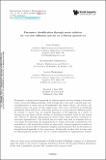Parameter identification through mode isolation for reaction-diffusion systems on arbitrary geometries
Abstract
We present a computational framework for isolating spatial patterns arising in the steady states of reaction-diffusion systems. Such systems have been used to model many natural phenomena in areas such as developmental and cancer biology, cell motility and material science. In many of these applications, often one is interested in identifying parameters which will lead to a particular pattern for a given reaction-diffusion model. To attempt to answer this, we compute eigenpairs of the Laplacian on a variety of domains and use linear stability analysis to determine parameter values for the system that will lead to spatially inhomogeneous steady states whose patterns correspond to particular eigenfunctions. This method has previously been used on domains and surfaces where the eigenvalues and eigenfunctions are found analytically in closed form. Our contribution to this methodology is that we numerically compute eigenpairs on arbitrary domains and surfaces. Here we present examples and demonstrate that mode isolation is straightforward especially for low eigenvalues. Additionally we see that the inhomogeneous steady state can be a linear combination of eigenfunctions. Finally we show an example suggesting that pattern formation is robust on similar surfaces in cases that the surface either has or does not have a boundary.
Citation
Murphy , L , Venkataraman , C & Madzvamuse , A 2018 , ' Parameter identification through mode isolation for reaction-diffusion systems on arbitrary geometries ' , International Journal of Biomathematics , vol. 11 , no. 4 , 1850053 . https://doi.org/10.1142/S1793524518500535
Publication
International Journal of Biomathematics
Status
Peer reviewed
ISSN
1793-5245Type
Journal article
Description
This work (LM) was supported by an EPSRC Doctoral Training Centre Studentship through the University of Sussex. CV and AM acknowledge support from the Leverhulme Trust Research Project Grant (RPG-2014-149) and the EPSRC grant (EP/J016780/1). This research was partly undertaken whilst LM, CV and AM were participants in the Isaac Newton Institute Program, Coupling Geometric PDEs with Physics for Cell Morphology, Motility and Pattern Formation. This work (AM) has received funding from the European Union Horizon 2020 research and innovation programme under the Marie Sklodowska-Curie grant agreement (No 642866). AM was partially supported by a grant from the Simons Foundation. AM is a Royal Society Wolfson Research Merit Award Holder, generously supported by the Wolfson Foundation. LM acknowledges the support from the University of Sussex ITS for computational purposes.Collections
Items in the St Andrews Research Repository are protected by copyright, with all rights reserved, unless otherwise indicated.

